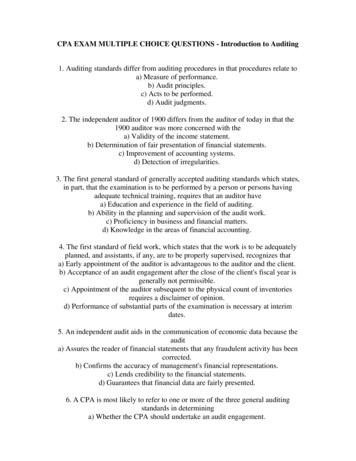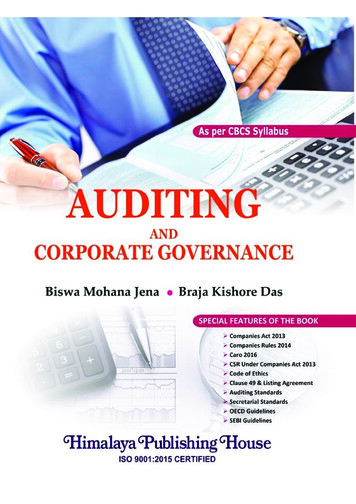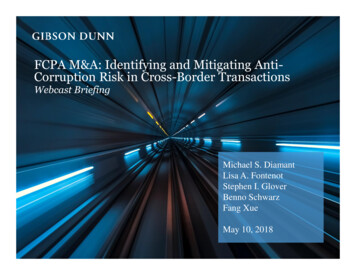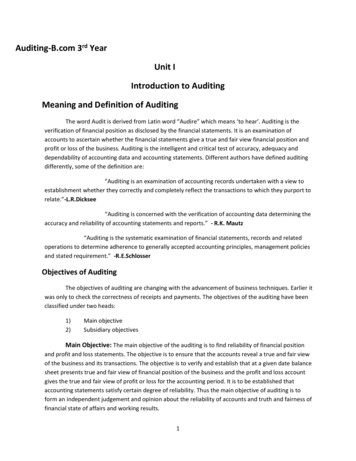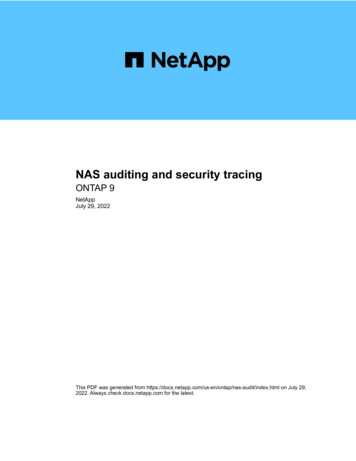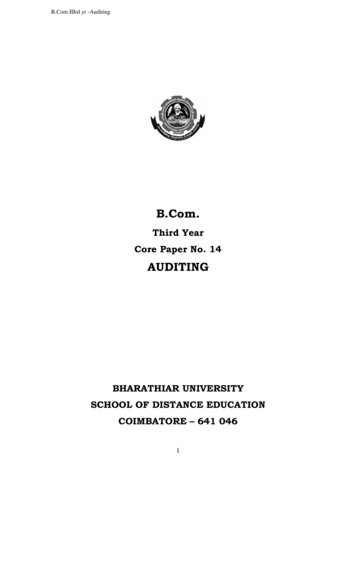
Transcription
Presenting a live 90-minute webinar with interactive Q&AFCPA Compliance: Auditing and MonitoringThird PartiesMinimizing Liability Risks When Using Sales Agents, Distributors and Other IntermediariesTUESDAY, APRIL 10, 20181pm Eastern 12pm Central 11am Mountain 10am PacificToday’s faculty features:Brent C. Carlson, Director, AlixPartners, San FranciscoEdward J. Fishman, Partner, Nossaman, Washington, D.C.George D. Martin, Partner, Faegre Baker Daniels, MinneapolisThe audio portion of the conference may be accessed via the telephone or by using your computer'sspeakers. Please refer to the instructions emailed to registrants for additional information. If youhave any questions, please contact Customer Service at 1-800-926-7926 ext. 1.
Tips for Optimal QualityFOR LIVE EVENT ONLYSound QualityIf you are listening via your computer speakers, please note that the qualityof your sound will vary depending on the speed and quality of your internetconnection.If the sound quality is not satisfactory, you may listen via the phone: dial1-866-570-7602 and enter your PIN when prompted. Otherwise, pleasesend us a chat or e-mail sound@straffordpub.com immediately so we can addressthe problem.If you dialed in and have any difficulties during the call, press *0 for assistance.Viewing QualityTo maximize your screen, press the F11 key on your keyboard. To exit full screen,press the F11 key again.
Continuing Education CreditsFOR LIVE EVENT ONLYIn order for us to process your continuing education credit, you must confirm yourparticipation in this webinar by completing and submitting the AttendanceAffirmation/Evaluation after the webinar.A link to the Attendance Affirmation/Evaluation will be in the thank you emailthat you will receive immediately following the program.For additional information about continuing education, call us at 1-800-926-7926ext. 2.
Program MaterialsFOR LIVE EVENT ONLYIf you have not printed the conference materials for this program, pleasecomplete the following steps: Click on the symbol next to “Conference Materials” in the middle of the lefthand column on your screen. Click on the tab labeled “Handouts” that appears, and there you will see aPDF of the slides for today's program. Double click on the PDF and a separate page will open. Print the slides by clicking on the printer icon.
FCPA Compliance:Auditing and MonitoringThird PartiesApril 10, 2018Presented by Ed Fishman for StraffordPublications Webinar
Overview of Presentation Topics Statutory Framework for Third Party Liability Recent Enforcement Actions Involving ThirdParties Evolving Expectations for Auditing andMonitoring Third Parties Unique Risks Created by Different ThirdParties Sales and Marketing Agents Distributors and Resellers Freight Forwarders, Brokers andLogistics Companies Consultants Other Intermediaries6
Summary of FCPA U.S. Foreign Corrupt Practices Act (FCPA)– Prohibits corruptly giving “anything of value” to a“foreign government official” in order to obtain orretain business or any improper advantage– Third party intermediaries acting on behalf of acompany can create FCPA liability if the companyignores “red flags” about their conduct– There is an exception for “facilitating payments”– There are affirmative defenses for “reasonable andbona fide” promotional expenses, paymentsrequired under a contract with a foreigngovernment agency, and payments allowed underthe written laws of a foreign country– Enforced by the DOJ and by the SEC7
Statutory Framework The FCPA prohibits a U.S. domestic concern or issuer frommaking corrupt payments both directly and indirectly through thirdparty agents, distributors or other intermediaries The anti-bribery provision prohibits the offer or payment of“anything of value” to a third party while “knowing” that all orsome of that payment will be offered or given by the third party toa “foreign official” for unauthorized purposes Knowledge can be established by:– Having actual knowledge that an improper payment will bemade.– Having constructive knowledge that an improper payment maybe made due to the existence of “red flags.”– Failing to conduct adequate due diligence or oversight of thethird party, which may cause U.S. authorities to take theposition that the knowledge element has been satisfied due towillful blindness/conscious disregard.8
Third Party Risk Profile One of the greatest FCPA risks facing companiestoday is from third party activity OECD estimates that approximately 75% of improperbribes are paid through third party intermediaries From a risk mitigation standpoint, it is imperative toobtain an understanding of the company’s third partyrisk profile based on the different types of third partiesthat work with the company, the structure of thebusiness/economic relationship with such thirdparties, the countries and industries in which thosethird parties conduct activities for or on behalf of thecompany, and the level of due diligence, oversightand monitoring of the activities of the third parties9
Recent Enforcement Actions Many of the largest FCPA settlements in historyhave involved violations caused by ororchestrated through the use of third parties:– Telia (2017): 965 million– VimpelCom (2016): 795 million– KBR/Halliburton (2009): 579 million Almost all of the recent FCPA settlements haveinvolved allegations relating to some level of thirdparty involvement, either as the conduit to makeimproper payments or the conduit to receiveimproper payments on behalf of the governmentofficials involved in the transaction10
Mitigating Third Party FCPA Risk Corporate liability often turns on the extent to which acompany undertook commercially reasonable effortsto detect and prevent violations.– See, e.g., Federal Sentencing Guidelines, Ch. 8,Part B, Remedying Harm From Criminal Conduct,and Effective Compliance and Ethics Program– An effective compliance program includes duediligence to prevent and detect criminal conductand taking reasonable steps to ensure thecompliance program is followed, includingmonitoring and auditing to detect criminal conduct DOJ/SEC Resource Guide states that “companiesshould undertake some form of ongoing monitoring ofthird-party relationships. Where appropriate, this mayinclude updating due diligence periodically, exercisingaudit rights, providing periodic training, and requestingannual compliance certifications by the third party.”11
Third Party Monitoring Expectations Deferred Prosecution Agreement withKeppel Offshore (DOJ 2017)– “anti-corruption policies and proceduresshall apply where necessary andappropriate, to outside parties acting onbehalf of the Company, including but notlimited to agents and intermediaries,consultants, representatives, distributors,teaming partners, contractors andsuppliers, consortia and joint venturepartners (collectively, “agents and businesspartners”)12
Third Party Monitoring Expectations “Where necessary and appropriate, theCompany shall implement the following withrespect to agents and business partners:– compliance training– compliance certifications– effective system for confidential reporting ofviolations and for providing advice/guidance– appropriate risk-based due diligence andcompliance requirements for retention andoversight, including right to audit books andrecords and right to terminate for violations”13
Theories of Third Party Liability Direct participation in third party misconduct Express or implied authorization of third partymisconduct (e.g. providing payment whileaware or substantially certain that third partywill pass along all/portion to foreign official) Knowledge of third party misconduct (e.g.awareness or substantial certainty that thirdparty will engage in misconduct, includingconscious avoidance) Direct liability for third party agent conduct ifundertaken within scope of agencyrelationship and intended (in part) to benefitthe principal14
Sales & Marketing Agents Commissioned sales agents have traditionally posed thehighest third party risk under the FCPA due to theirsignificant, often unsupervised interaction with potentialcustomers on behalf of their principals U.S. enforcement authorities now expect U.S. companiesto conduct some level of due diligence into the activitiesof their foreign sales agents and to implement certaininternal controls designed to monitor the activity of salesagents in order to detect potential “red flags” Embraer (2017): Recent FCPA enforcement actioninvolving third party sales agent with no experience in therelevant industry or region Lindsey Manufacturing (2011): Lindsey and two of its topexecutives were convicted of violating the FCPA after afive-week trial. The jury concluded that Lindsey’s salesrepresentative in Mexico secured contracts for thecompany by passing a portion of his 30% commission toofficials from Mexico’s state-owned electric utility.15
Distributors & Resellers Distributors and resellers traditionally perceived as posingless risk than sales agents because they obtain title to thegoods from the manufacturer or retailer, but FCPA riskinvolving distributors and resellers can be significant insituations where the manufacturer/retailer relies on thedistributor to identify specific sales opportunities Teva Pharmaceutical (2016): Mexican subsidiary allegedlygave improper discounts to distributor to create cash marginfor improper payments; Russian subsidiary allegedly soldproducts to distributor owned by Russian procurement official Smith & Nephew plc (2012): Medical device company allegedlysold products at full list price to Greek distributor and then paiddiscount to an off-shore shell company controlled by thedistributor to create off-the-books funds to make corruptpayments Invision Technologies (2005): Invision executives were allegedto be aware of a “high probability” that its distributors/resellersin China and Thailand were bribing foreign officials to securecontracts for the sale of baggage screening equipment topublic airports.16
Freight Forwarders, Brokers and 3PLs Freight forwarders, customs brokers and logisticsproviders can create FCPA risk for their customers dueto their frequent interaction with foreign officials atcustoms clearance facilities and ports of entry. Weatherford (2013): Oil services provider allegedly useda freight forwarding company to funnel bribes to Africanforeign official for renewal of oil services contract bygenerating sham purchase orders and invoices forservices that the freight forwarder never performed. Panalpina (2010): Panalpina was charged with aidingand abetting its customers’ violations of the FCPA byacting as an agent of several U.S. issuers on behalf ofwhom it made allegedly corrupt payments to expediteproducts through the customs processes of severalcountries. Vetco Gray (2007): Employees of three Vetco Grayentities allegedly were aware that their customs agentcontinuously bribed Nigerian customs officials to gainpreferential customs treatment and clearance for VetcoGray products.17
Consultants Consultants are often used as the conduits for improperpayments under the guise of sham consulting servicecontracts, and these companies working with consultants inhigh-risk markets should verify that the consultants areproviding actual services and are being paid fair market valuefor those services Alstom (2014): French power company allegedly paid 75million to third party consultants to secure more than 4 billionworth of projects in various countries while “knowing” that atleast a portion of the consultant payments would be used tobribe foreign officials in those countries Diageo (2011): Diageo allegedly engaged a consulting firm tolobby the Thai government regarding various customs and taxdisputes and through this arrangement approximately 600,000 in corrupt payments were paid to a Thai official. Alcatel-Lucent (2010): Alcatel allegedly engaged numerouscommissioned “consultants” in several countries, who paid forbribes, gifts, entertainment, and travel expenses ofgovernment officials to receive information and other businessadvantages on behalf of Alcatel, despite numerous “red flags”that these consultants were making corrupt payments.18
Other Intermediaries U.S. enforcement authorities will be suspicious if anytransaction involves companies that do not appear to beengaged in any substantive activities (so-called “shellcompanies”), particularly if they are located in off-shorebanking jurisdictions. These companies often an used tomake corrupt payments and to keep the payments off thebooks and records of the issuers and their subsidiarieswho are making the payments. Telia (2017): Swedish telecom company allegedly paidbribes to a shell company that members of its managementknew was beneficially owned by a Uzbek governmentofficial Cinergy and Terra Telecommunications (2011): Cinergyand Terra executives allegedly used a series of shellcompanies to launder money to pay bribes to Haitiantelecommunications officials for favorable contract terms. Comverse Technologies (2010): Executives atComverse’s Israeli subsidiary allegedly directed its agent toestablish a shell company through which Comverse,Comverse employees, and the agent transferred money toGreek government officials.19
QUESTIONS? Contact:Ed FishmanNossaman LLP1666 K Street N.W.Suite 500Washington, D.C. 20006(202) 887-1410 (direct)efishman@nossaman.com20
Planning Third PartyAudit & ComplianceReviewsGeorge D. Martingeorge.martin@FaegreBD.com
Audit Objectives & Scope of Work Strongcompliance programs can deter and detect violations, but nocompliance program can completely prevent violations from occurring Goalof periodic auditing is to evaluate and improve effectiveness ofthird party (“TP”) compliance and suitability of TP relationships and tosend message to market that you take compliance seriouslyIt is expected by the U.S. enforcement authorities, helps establish an“adequate procedures” defense under the UK Bribery Act, and deliversvalue from a business perspective as well22
Set-Up Successful Audit Beginswith a proper vetting and on-boarding process, culminating instrong compliance contract terms that include audit and terminationrights Next: Develop a written TP audit protocol for internal transparency,understanding and consistent application Get business team buy-in—explain need and benefits, and solicit theirsupport in TP communications and audit execution Understand legitimate fears/concerns of TPsScope; disruptive; access to proprietary business information Underscore that audit focus is limited to TP’s performance of andcompliance with your contract23
Audit Objectives & Scope of Work Audit firm needs local forensic accounting and ABAC expertiseAudit firm engagement should be via legal counsel, with auditorsworking “at the direction of counsel,” all for privilege purposesAudit focus should be to confirm the TP’s business bona fides,assess its internal control environment, and evaluate its adherenceto its contractual compliance obligations (esp. GT&E practices,marketing spend).Audit will require TP’s cooperation, with full access to relevantrecords and back-up documentation, plus interviews of key teammembers servicing your business24
Audit Play Book and Sequencing of Work Stream Sequencingof process is important:Outline objective and scope of auditDevelop standard draft Work PlanDevelop agenda and talking points for call with internal liaison to TPGather readily available information via Internal Document Request ListDevelop agenda and discussion points for kick-off call with TPCustomize Document Request List for TP; send after TP kick-off callAuditors commence on-site work, while legal counsel reviews otherrelevant written materials provided in response to Document RequestList25
Audit Play Book and Sequencing of Work StreamAuditors report findings / developments to inside and outside legal andcompliance teamsReview of initial audit findings and confer with AuditorsUse analyses to outline questions/discussion points for interviewsSchedule telephone interviews; include both auditors and outsidecounsel, as well as translation support if/as necessaryAuditors and outside counsel collaborate in preparing joint report andadhering to agreed form, with specific recommendations includedDebrief and address questions with in-house legal/compliance teams26
Audit Objectives & Scope of Work Auditingall third parties is not practical, so develop risk matrix toassess relative risk presented by each relationship and prioritize.Consider:Geographic reputation for corruption riskNature of services being provided and compensation arrangementsInvolvement in the business of any state-owned, -controlled or -affiliatedorganizationsIndustryReputational and anecdotal informationMake reference to original intake diligence fileUse an objective numerical ranking system as well as experience-based,subjective judgments to prioritize27
Designing the Audit: Areas of Priority FocusKeep audit process as simple, non-disruptive and cost-effective aspossible (while still being thorough). The process has to be affordableand sustainable. Examples of priority areas of interest include:Updated information regarding any TP investigations, incidents orallegations involving bribery/corruption/fraudReview and test TP’s Code of Conduct, GT&E policy (if any) and relatedprotocols and procedures to assure compliance therewithTransaction testing regarding documentation for use of petty cash, gifts,travel, entertainment, general marketing, and any charitable or politicalcontributions related to your businessExamine any TP disbursements and the use of any other sub-contractedTPs supporting the business; if any, scrutinize their fees and services28
Final Steps Consideruse of independent compliance committee to organizeprocess, conduct risk assessment and be responsible for remediation29
Questions?George MartinFaegre Baker Daniels LLP2200 Wells Fargo Center90 South Seventh StreetMinneapolis, MN 55402(612) 766-7055 (direct)george.martin@FaegreBD.comGeorge Martin is a partner of Faegre Baker Daniels, wherehe also serves on the Management Board. He Co-chairsFaegreBD’s global anti-bribery/anti-corruption practice,with extensive experience in Asia, Eastern Europe, LatinAmerica, the Middle East and Africa. He practiced law for 5years in Eastern Europe and China. Mr. Martin’sexperience includes leading and conducting FCPAinvestigations worldwide, and providing M&A FCPA duediligence on cross-border transactions, day-to-daycompliance counseling to multinational clients regardingtheir global operations and third party intermediaryrelationships, as well as related compliance policies andprocedures. He also has extensive experience partneringwith FaegreBD’s white-collar team in appearing before theU.S. Department of Justice and Securities and ExchangeCommission in connection with FCPA voluntarydisclosures.30
FCPA Compliance: Auditing andMonitoring Third PartiesPresented by Brent Carlson for Strafford Publications Webinar10 April 2018
Avoid Missing the Elephant in the Room –First Take a Step Back and Think about the SituationBefore jumping into any testing, first take a step back and look at the bigger picture to avoid missing theelephant in the room. There are two common pitfalls if one does not first take a step back and lookthoughtfully at the situation.32
Understanding an Entity’s Business Starts with Knowing itsParticular Pressure PointsThe Fraud Triangle provides a conceptual framework to understand the underlying elements that come together tocreate an environment conducive to produce fraud and corruption.For individuals in companies itall starts with some sort ofpressure.For example:PRESSUREChina’s New NormalUnderstanding these pressuresrequires knowledge of thecompany’s evolving businessand economic drivers.Compliance programs focus on the“Opportunity” part of the triangle.FRAUDTRIANGLEOPPORTUNITY Continued aggressive marketexpectations amid adeteriorating business climate Liquidity issues in customernetworks and supply chains Highly-competitive marketwith overcapacity in manysectors Continued high levels of stateownership in the economyRATIONALIZATION Weak corporate governance structures “I need to do this for my business to survive.” Weak finance and accounting teams “My competitors all do the same.” Under-developed internal controls Environment of imperfect information“If I don’t take these steps now the window ofopportunity will close.” 山高皇帝远 “The mountains are high andthe emperor is far away.” Evolving moral and ethical framework33
Understanding Key Drivers – Economic, Business, and RegulatoryGrasp the “Revenue” and “Regulatory” elements of the entity’s operationsExample: Top Challenges for Multinationals in China1.Competition with Chinese companies in China2.Cost Uneven enforcement or implementation of Chinese laws7.Human resources8.Intellectual property rights enforcement9.Foreign investment restrictions10.National treatmentThese operational issues all point to greater downward pressure onmargins and increased pressure for fraud and compliance challenges.The above example applies to China; every global location will havedifferent priority issues.The two main over-archingoperational risk categoriesin terms of anti-corruptioncompliance are Revenueand Regulatory and theseare reflected in theseoperational issues.Third parties are used forone of these two overarching areas.By understanding thelatest developments andtrends in each location’sbusiness this conceptualframework can helpprioritize elements for aneffective testing plan.Source: US-China Business Council’s China Business Environment Survey34
Common Corruption-Related Fraud Schemes A Shift Over Time to More Use of Third PartiesFraudulent DisbursementsExpense Reimbursement SchemesBilling ll SchemesBogus Vendor/Shell CompanyHowever, note that with the increased awareness of corruption issues around the world,there has been a general evolution corruption-related schemes:From higher volume / lower dollar value schemes(like excessive meals, gifts, and travel) to lower volume/higher dollar value schemeswith more creative, hidden approaches(with an emphasis on the use of 3rd parties)35
Common Red Flags with Third PartiesBasic Nuts and Bolts – Obvious Issues Reputation for paying or receiving bribes A history of corruption in the country or industry No physical address for its business operations True ownership of the business unknown or opaque Will not sign an anti-corruption certification that no corrupt payments will be made Refuses to include – or abide by - an audit clause and/or anti-corruption complianceclauseMore Subtle Red Flags Apparent lack of qualifications or resources to perform services provided Third party was recommended by a government official Unusual payment patterns or financial arrangements Questionable and excessive commissions and expenses for which there is no reasonable,rational and explainable accounting36
Common Testing MistakesUnder-Testing Key Areas While Over-Testing Less Relevant Ones Testing low-risk third parties and missing the higher risk ones Taking a set amount of random samples across the general ledger (e.g., random 10% oftransactions across all GL accounts) Over-reliance on specific threshold amounts Taking an automated, cookie-cutter approach to the testing process Not understanding the key drivers of the entity’s businessPsychological biases influencing the testing process Need a flexible approach Take an objective look at the drivers of the entity’s business37
Missing the Elephant in the Room – Part TwoThe Human Element ”The Secret of Steel”Not fully appreciating or aware of the human elements which runat the core of compliance and investigative mattersKey Problems Include: Compliance processes left onautopilot Over-reliance on technology toolsas a cure-all Psychological bias ininvestigations and compliancematters 38
Psychological bias in investigations and compliance mattersTypes of biasBias – Three common types:StereotypesA stereotype is an exaggerated belief, image, or distorted truth about a category of people or an individual member of thatcategory. A stereotype can be either positive or negative.Stereotypes are often created or reinforced by mass media, but they are also passed on (perhaps unintentionally) by parentsand family members, teachers, religious leaders, and other respected individuals.PrejudiceA prejudice is an opinion, prejudgment, or attitude about a category of people or individual members of that category.Prejudice is often thought of as a negative feeling toward members of a group, but prejudices can be positive, too.Implicit prejudice, the type that the holder is not consciously aware of, is everywhere in the workplace. When an investigativeor compliance professional begins an assignment and meets the CFO, who is a gray haired and older than the investigativeprofessional, what sort of expectations might the investigative professional form? Would those expectations differ if the CFOwas much younger?DiscriminationDiscrimination is behavior that treats people unequally as a result of their group memberships. Discrimination often starts outas a stereotype or a prejudice.If professionals are not aware of their stereotypes and prejudices, or if they are but do not properly address them, these canaffect workplace actions and can lead compliance and investigative work plans off-track.Source: Association of Certified Fraud Examiners, “Overcoming Bias in Investigations and Audits”39
Psychological bias in investigations and compliance mattersPotential harmful impacts if bias goes uncheckedCompliance MattersHarmful effects of bias include: The reviewer/auditor gives insufficient consideration to the risk of fraud/corruption in the planning stages of theaudit because she/he has had positive past experiences with the local entity’s personnel and third parties. The reviewer/auditor accepts management’s explanations and representations without sufficient corroboration. Reviewers/auditors fail to recognize red flags thereby missing the elephants in the room Failure to catch potential issues up front leading to risk of bigger disasters down the roadInvestigationsBias can have any of the following effects on an investigation as well: The real perpetrator gets away.The wrong person is punished and that person’s reputation is unfairly tarnished.The reputation of and trust in the investigative function is damaged.Workforce morale is weakened.The organization faces negative publicity.A terminated employee represents a potential financial liability.Source: Association of Certified Fraud Examiners, “Overcoming Bias in Investigations and Audits”40
Psychological bias in investigations and compliance mattersExamples of potential impactExample 1Bias in Performing Analyses and Reliability of Management/Employees ExplanationsBias is particularly harmful with respect to over-reliance on explanations from management or not adequately following through oncertain explanations. Bias can impair an examiner’s ability to apply professional skepticism to the responses from management andothers in connection with analytical procedures.Example 2Bias in Planning Compliance Audits/ReviewsBuilding on the preceding bias, internal investigative and compliance professionals plan their audit procedures based on a riskassessment. Part of this assessment involves identifying fraud risks and assessing their likelihood and significance. Repeatedexposure to certain personnel in environments without significant frauds or ethical breaches in the past, can lull an examiner into afalse confidence that fraud risks are minimal. And if the examiner does not identify significant risks during the assessment, theresulting audit/review plan will exclude key relevant risk profile elements.Example 3Bias in Performing ProceduresExaminers make judgments all the time while performing audit procedures. What constitutes an exception in a test? It is a simplequestion, but anyone who has conducted transaction testing understands that the answer is not always so simple.Testing procedures use significant judgment and professional skepticism for decisions about which test results require follow up orexplanation and which do not. These judgments and an examiner’s professional skepticism are shaped, in part, by the implicit biasesbrought into the workplace.Source: Association of Certified Fraud Examiners, “Overcoming Bias in Investigations and Audits”41
Psychological bias in investigations and compliance mattersCharacteristics to help overcome potential biasAble to Suspend Judgment This characteristic was described all the way back in Statement on Auditing Standards No. 1 asan essential element of professional skepticism. Investigators and auditors should wait to form judgments until they haveobtained and considered sufficient evidence.Informed Good skeptics gather information and are not satisfied until they have reviewed and understood all of the relevantdata, including any facts that might conflict with their existing hypothesis.Ethical Good skeptics seek the truth and are not easily influenced or swayed. They do not waver in abiding by standards ofethics and integrity.Curious Good skeptics are not doubtful of everything they are told, but they do have a natural curiosity and questioningminds. They do not blindly accept everything they are told as being correct and complete.Good skeptics have a natural desire to search for knowledge.Self-Confident Good skeptics are not easily deterred by the latest piece of information or attempted persuasion frommanagement. Rather, they take in all
Many of the largest FCPA settlements in history have involved violations caused by or orchestrated through the use of third parties: -Telia (2017): 965 million -VimpelCom (2016): 795 million -KBR/Halliburton (2009): 579 million Almost all of the recent FCPA settlements have involved allegations relating to some level of third
